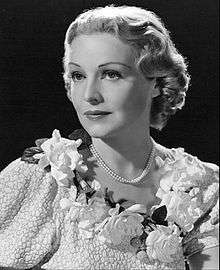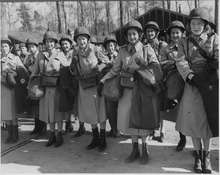Madeleine Carroll
Edith Madeleine Carroll (26 February 1906 – 2 October 1987)[1] was an English actress, popular both in Britain and America in the 1930s and 1940s. At the peak of her success in 1938, she was the world's highest-paid actress.
Madeleine Carroll | |
|---|---|
 Carroll in 1938 | |
| Born | Edith Madeleine Carroll 26 February 1906 West Bromwich, Staffordshire, UK |
| Died | 2 October 1987 (aged 81) Marbella, Spain |
| Resting place | Sant Antoni de Calonge |
| Occupation | Actress |
| Years active | 1928–1955 |
| Spouse(s) | Captain Phillip Astley (1931–1939) Sterling Hayden (1942–1946) Henri Lavorel (1946–1949) Andrew Heiskell (1950–1965) |
Carroll is remembered for her role in Alfred Hitchcock's The 39 Steps (1935). She is also noted for largely abandoning her acting career after the death of her sister Marguerite in the London Blitz to devote herself to helping wounded servicemen and children displaced or maimed by the war.
Early life
Carroll was born at[2] 32 Herbert Street (now number 44) in West Bromwich, Staffordshire, daughter of John Carroll, an Irish professor of languages from County Limerick, and Helene, his French wife. She graduated from the University of Birmingham, with a B.A. degree; while at university she appeared in some productions for the Birmingham University Dramatic Society. She was a French mistress at a girls' school in Brighton for a year.[3]
Acting career
Early years
Carroll wanted to act and left teaching to look for roles. She got a job in the touring company of Seymour Hicks.[4]
She made her stage debut with a touring company in The Lash. Widely recognised as one of the most beautiful film actresses (she won a film beauty competition to start herself off in the business), Carroll's aristocratic blonde allure and sophisticated style were first glimpsed by film audiences in The Guns of Loos in 1928.
Film stardom
Carroll was the lead in her second film, What Money Can Buy (1928) with Humberston Wright. She followed it with The First Born (1928) with Miles Mander, which really established her in films.[4][5]
Carroll went to France to make Not So Stupid (1928). Back in Britain she starred in The Crooked Billet (1929) and The American Prisoner (1929), both shot in silent and sound versions.
Carroll was in Atlantic (1930),[6] then co-starred with Brian Aherne in The W Plan (1930). In France she was in Instinct (1930).
On stage, Carroll appeared in The Roof (1929) for Basil Dean,[7] The Constant Nymph, Mr Pickwick (opposite Charles Laughton) and an adaptation of Beau Geste.[8]
Carroll starred in the controversial Young Woodley (1930), then a farce, French Leave (1930). She had a support role in an early adaptation of Escape (1930) and was the female lead in The School for Scandal (1930) and Kissing Cup's Race (1930).
Carroll was a French aristocrat in Madame Guillotine (1931) with Aherne, then did another with Mander, Fascination (1931). She was in The Written Law (1931), then signed a contract with Gaumont British for whom she made Sleeping Car (1932) with Ivor Novello.[9]
Carroll had a big hit with I Was a Spy (1933), which won her an award as best actress of the year. It was directed by Victor Saville.[10]
She played the title role in the play Little Catherine. Abruptly, she announced plans to retire from films to devote herself to a private life with her husband, the first of four.
Carroll went to Hollywood to appear in The World Moves On (1934) for Fox; John Ford directed and Franchot Tone co starred. Back in England she was in The Dictator (1935) for Saville, playing Caroline Matilda of Great Britain.
Hitchcock
Carroll attracted the attention of Alfred Hitchcock and in 1935 starred as one of the director's earliest prototypical cool, glib, intelligent blondes in The 39 Steps. Based on the espionage novel by John Buchan, the film became a sensation and with it so did Carroll. Cited by The New York Times for a performance that was "charming and skillful",[11] Carroll became very much in demand. Of Hitchcock heroines as exemplified by Carroll, film critic Roger Ebert wrote:
The female characters in his films reflected the same qualities over and over again: They were blonde. They were icy and remote. They were imprisoned in costumes that subtly combined fashion with fetishism. They mesmerised the men, who often had physical or psychological handicaps. Sooner or later, every Hitchcock woman was humiliated.[12]
The director wanted to re-team Carroll with her 39 Steps co-star Robert Donat the following year in Secret Agent, a spy thriller based on a work by W. Somerset Maugham. However, Donat's recurring health problems intervened, resulting in a Carroll–John Gielgud pairing. In between the films she made a short drama The Story of Papworth (1935).
Hollywood
_1.jpg)
Poised for international stardom, Carroll was the first British beauty to be offered a major American film contract. She accepted a lucrative deal with Paramount Pictures and was cast opposite George Brent in The Case Against Mrs. Ames (1936).
Carroll followed this with The General Died at Dawn (1936).
She was borrowed by 20th Century Fox to play the female lead in Lloyd's of London (1936) which made a star of Tyrone Power. She stayed at the studio to make On the Avenue (1937), a musical with Dick Powell and Alice Faye.
Carroll went to Columbia for It's All Yours (1937) then was cast by David O. Selznick as Ronald Colman's love interest in the 1937 box-office success The Prisoner of Zenda.
Walter Wanger put her in Blockade (1938) with Henry Fonda, about the Spanish Civil War. Back at Paramount she made some comedies with Fred MacMurray, Cafe Society (1939) and Honeymoon in Bali (1939). Edward Small gave her top billing in My Son, My Son! (1940) with Aherne.
Carroll was in Safari (1940) then played against Cooper again in North West Mounted Police (1940), directed by Cecil B. DeMille.
Paramount put her opposite MacMurray in Virginia (1941) and One Night in Lisbon (1941). Virginia also starred Sterling Hayden who was reteamed with Carroll in Bahama Passage (1941). Carroll was Bob Hope's love interest in My Favorite Blonde (1942).
Radio
On radio, Carroll was a participant in The Circle (1939) on NBC, discussing "current events, literature and drama" each week.[13] In 1944, she was the host of This Is the Story, an anthology series dramatising famous novels on the Mutual Broadcasting System.[13]:332 At the tail end of radio's golden age, Carroll starred in the NBC soap opera The Affairs of Dr. Gentry (1957-59). She also was one of a group of four stars who rotated in taking the lead in each week's episode of The NBC Radio Theater (1959).[13]:252
Return to Britain
Carroll returned to Britain after the war. She was in White Cradle Inn (1947). She went back to the US and was reunited with MacMurray for An Innocent Affair (1948). Her last film was The Fan (1949).
Legacy
For her contributions to the film industry, Carroll was inducted into the Hollywood Walk of Fame in 1960 with a motion pictures star located at 6707 Hollywood Boulevard.[14]
A commemorative monument and plaques were unveiled in her birthplace, West Bromwich, to mark the centenary of her birth. Her story is one of rare courage and dedication when at the height of her success she gave up her acting career during World War II to work in the line of fire on troop trains for the Red Cross in Italy after her sister was killed by a German air raid – for which she was awarded the American Medal of Freedom. She was also awarded the Legion of Honour by France for her tireless work in fostering relations postwar amity between France and the United States.
Personal life


She divorced her first husband, Colonel Philip Reginald Astley, in 1939. He was an estate agent, big-game hunter and soldier. In 1941, she starred opposite Sterling Hayden in Virginia. They married in February 1942 and divorced in May 1946.
After her only sister, Marguerite, was killed in World War II's London Blitz, Carroll made a radical shift from acting to working in field hospitals as a Red Cross nurse. Having become a naturalised US citizen in 1943, she served at the American Army Air Force's 61st Station Hospital in Foggia, Italy, in 1944, where wounded airmen flying out of area's air bases were hospitalised.
During the war, Carroll also donated her château outside Paris to more than 150 orphans, arranging for groups of young people in California to knit clothing for them. In an RKO-Pathe News bulletin she was filmed at the château with children and staff wearing the donated clothes thanking those who contributed. She was awarded the Légion d'honneur for her efforts by France. Allied Commander Dwight Eisenhower remarked in private that, of all the movie stars he met in Europe during the war, he was most impressed with Carroll and Herbert Marshall (who worked with military amputees).[15]
After the war, Carroll stayed in Europe where she conducted a radio program fostering French-American friendship and helped in the rehabilitation of concentration camp victims, during which she met her future third husband, the French producer Henri Lavorel. In late 1946, she went briefly to Switzerland to film a British film, White Cradle Inn (aka High Fury).[16]
On her return to Paris, she and Lavorel formed a production company and made several two-reel documentaries to "promote better understanding among the peoples of the world"; one, Children's Republic, was shown at the Cannes Film Festival. Filmed in a small orphanage in the town of Sèvres, just southwest of Paris, it focused attention on the devastation of children's lives in Europe caused by war. Widely shown in Canada, it became a prime source of funds for the manufacture of artificial limbs for wounded children.
In 1947, Carroll returned to the US together with Lavorel. Their intention was for her to resume her acting career, which would fund their production company, but they soon separated. Appearing in three more films until 1949 and debuting on Broadway in 1948, Carroll then mostly retired from acting, although she did occasionally appear on television and radio until the mid-1960s.
She married Andrew Heiskell, publisher of Life, in 1950, and they had a daughter Anne Madeleine in 1951. (A news feature in the 24 November 1958, edition of the Lubbock Evening Journal said that Carroll "married Heiskell ... in 1949.")[17] They divorced in 1965. By then, Carroll had moved to Paris. She later moved to Spain, where she shared an estate with her mother and her daughter. Her mother died in 1975 and her daughter, having relocated to New York, died in 1983.
Death
Carroll died on 2 October 1987 from pancreatic cancer in Marbella, Spain age 81. Initially interred in Fuengirola, Málaga, she was reburied in 1998 in the cemetery of Sant Antoni de Calonge in Catalonia.
Filmography
- The Guns of Loos (1928) as Diana Cheswick
- What Money Can Buy (1928) as Rhoda Pearson
- The First Born (1928) as Lady Madeleine Boycott
- Not So Stupid (1928)
- The Crooked Billet (1929) as Joan Easton
- The American Prisoner (1929) as Grace Malherb
- Atlantic (1929) as Monica
- The W Plan (1930) as Rosa Hartmann
- Instinct (1930)
- Young Woodley (1930) as Laura Simmons
- French Leave (1930) as Mlle. Juliette / Dorothy Glenister
- Escape (1930) as Dora
- The School for Scandal (1930) as Lady Teazle
- Kissing Cup's Race (1930) as Lady Molly Adair
- Madame Guillotine (1931) as Lucille de Choisigne
- Fascination (1931) as Gwenda Farrell
- The Written Law (1931) as Lady Margaret Rochester
- Sleeping Car (1933) as Anne
- I Was a Spy (1933) as Martha Cnockhaert
- The World Moves On (1934) as Mrs. Warburton, 1825 / Mary Warburton Girard, 1914
- The Dictator (1935) as Queen Caroline Mathilde of Denmark
- The 39 Steps (1935) as Pamela
- The Story of Papworth, the Village of Hope (1935, short) as The Introducer
- Secret Agent (1936) as Elsa Carrington
- The Case Against Mrs. Ames (1936) as Hope Ames
- The General Died at Dawn (1936) as Judy Perrie
- Lloyd's of London (1936) as Lady Elizabeth
- On the Avenue (1937) as Mimi Caraway
- It's All Yours (1937) as Linda Gray
- The Prisoner of Zenda (1937) as Princess Flavia
- Blockade (1938) as Norma
- Cafe Society (1939) as Christopher West
- Honeymoon in Bali (1939) as Gail Allen
- My Son, My Son! (1940) as Livia Vaynol
- Safari (1940) as Linda Stewart
- Northwest Mounted Police (1940) as April Logan
- Virginia (1941) as Charlotte Dunterry
- One Night in Lisbon (1941) as Leonora Perrycoate
- Bahama Passage (1941) as Carol Delbridge
- My Favorite Blonde (1942) as Karen Bentley
- White Cradle Inn (1947) as Magda
- An Innocent Affair (1948) as Paula Doane
- The Fan (1949) as Mrs. Erlynne
Radio appearances
| Year | Program | Episode/source |
|---|---|---|
| 1937 | Lux Radio Theater | "Beloved Enemy" |
| 1938 | Lux Radio Theater | "Romance" |
| 1938 | Lux Radio Theater | "Dangerous" |
| 1938 | Lux Radio Theater | "Another Dawn" |
| 1939 | The Campbell Playhouse | "The Green Goddess"[18] |
| 1939 | Lux Radio Theater | "Invitation to Happiness" |
| 1940 | Lux Radio Theater | "My Son, My Son!" |
| 1940 | The Campbell Playhouse | "Jane Eyre"[19] |
| 1941 | Philip Morris Playhouse | "My Favorite Wife"[20] |
| 1942 | Philip Morris Playhouse | "Vivacious Lady"[21] |
See also

References
- "Madeleine Carroll Dies at 81; Film Actress of 30's and 40's". nytimes.com.
- General Register Office for England and Wales index Volume 6b page 638
- "MADELEINE CARROLL". Lithgow Mercury. New South Wales, Australia. 5 July 1944. p. 4. Retrieved 3 October 2017.
- "BIOGRAPHY OF MADELEINE CARROLL". The National Advocate. Bathurst, New South Wales. 2 March 1939. p. 4. Retrieved 3 October 2017.
- "CAMERA ORDEALS". Saturday Journal. XLIV (16475). South Australia. 12 January 1929. p. 4. Retrieved 3 October 2017.
- "ATLANTIC". The Sydney Morning Herald (28, 665). 18 November 1929. p. 11. Retrieved 3 October 2017.
- "THE ROOF". Sunday Mail (343). Queensland, Australia. 22 December 1929. p. 12. Retrieved 3 October 2017.
- "MADELEINE CARROLL". Sunday Times (1684). Western Australia. 4 May 1930. p. 9. Retrieved 3 October 2017.
- "MADELEINE CARROLL". Northern Star. 57. New South Wales, Australia. 13 May 1933. p. 4. Retrieved 3 October 2017.
- "BEST FILM PERFORMANCE LAST YEAR". The Examiner. XCVI (102) (LATE NEWS EDITION and DAILY ed.). Tasmania, Australia. 9 July 1937. p. 8. Retrieved 2 October 2017.
- Andre Sennwald, "Alfred Hitchcock's New Picture, "The Thirty-Nine Steps,' " The New York Times, September 14 1935. Retrieved 12 March 2013.
- Roger Ebert, review of Vertigo, October 13 1996. Retrieved 12 March 2013.
- Terrace, Vincent (1999). Radio Programs, 1924–1984: A Catalog of More Than 1800 Shows. McFarland & Company, Inc. p. 76. ISBN 978-0-7864-4513-4.
- "Hollywood Walk of Fame – Madeleine Carroll". walkoffame.com. Hollywood Chamber of Commerce. Archived from the original on 3 April 2016. Retrieved 11 February 2018.
- Kochendoerfer, Violet A. (1994). One Woman's World War II. University Press of Kentucky. p. 149. ISBN 0813118662.
- "White Cradle Inn (1947)". Internet Movie Database. Retrieved 19 March 2017.
- "Madeleine Carroll Prefers Anonymity". Lubbock Evening Journal. Texas, Lubbock: Newspapers.com. WNS. 24 November 1958. p. 39. Retrieved 2 May 2017.

- "The Campbell Playhouse: The Green Goddess". Orson Welles on the Air, 1938–1946. Indiana University Bloomington. 10 February 1939. Retrieved 25 July 2018.
- "The Campbell Playhouse: Jane Eyre". Orson Welles on the Air, 1938–1946. Indiana University Bloomington. 31 March 1940. Retrieved 29 July 2018.
- "Robinson-Zivic Fight". Harrisburg Telegraph. Newspapers.com. 31 October 1941. p. 19. Retrieved 22 July 2015.

- "Madeleine Carroll Returns in Playhouse 'Vivacious Lady'". Harrisburg Telegraph. Newspapers.com. 7 February 1942. p. 26. Retrieved 1 August 2015.

External links
| Wikimedia Commons has media related to Madeleine Carroll. |